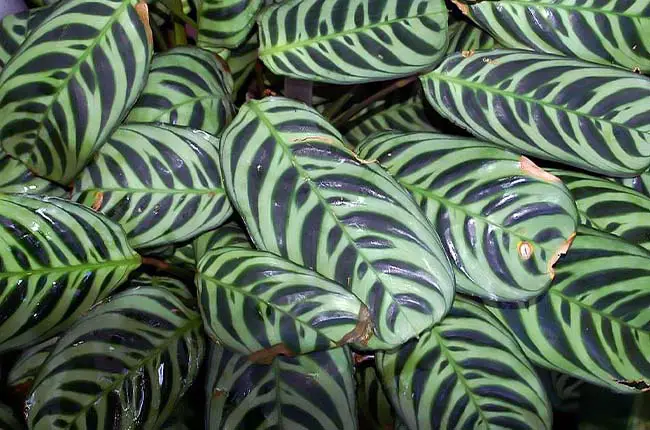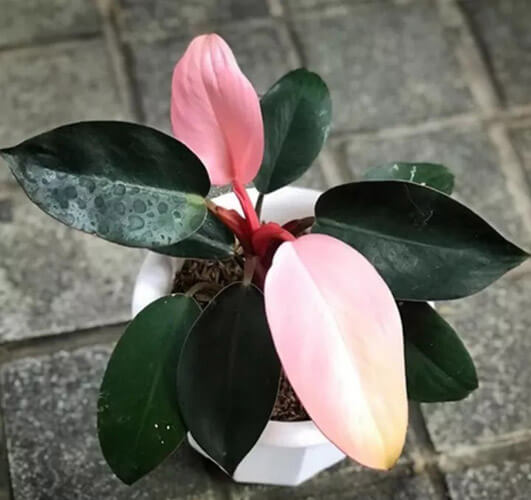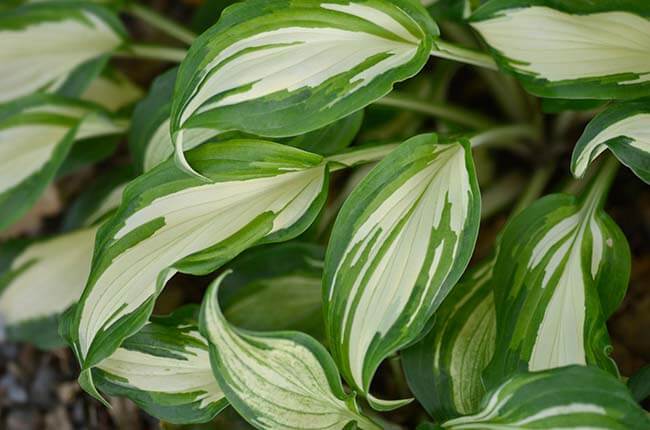Plants with variegated colored patterns are rare, beautiful gems for any plant collection.
How to induce variegation in your plants?
The best way to induce variegation in plants is to propagate a genetically variegated plant or the variegated parts of a plant with mutated plant cells that lack the green pigment. Inducing changes artificially by chemicals, radiation and virus is often not permanent and even dangerous for home gardeners.
In this article, we will take an in-depth look at the different ways most nurseries use and the best one home gardeners can use to create variegation in plants.
What does variegation look like in plants?
Variegation is the presence of distinct markings of different colors on a plant.
The markings mostly manifest as stripes, patches, rings, or spots, which can be regular or irregular in shape.
Variegation mostly appears on the margins or the center of leaves, but it can also appear in flower petals, stems, and even fruits.
The colors can be white, yellow, different shades of green, pink, and purple.
Such variegation is different from the variegation caused by sun stress, which results in colors of red, purple, blue, or black due to the release of a chemical called anthocyanin.
What causes variegation
A simple explanation for a variegated appearance is an uneven distribution of the green pigment chlorophyll, in the plant cells.
More specifically, variegation results when there is a combination of mutated plant cells that are incapable of producing chlorophyll and plant cells capable of producing chlorophyll at the meristems at the shoot tips (where cell division and new leaves are formed).
This can happen naturally, induced by human intervention using chemicals, radiation, and virus.
1. Naturally
For some plants, variegation occurs naturally as part of their physiology. There are three types of natural variegation depending on whether the genetic mutation only happens to some parts of the plant or the entire plant. They are:
- Chimeral variegation
- Gene pattern variegation
- Blister or reflective variegation
Chimeral variegation
Plants with chimeral variegation result in variegated patterns due to cell mutation at the meristems or shoot tips where new cells are produced.
If the mutation happens to only some cells of the plant with regular plant cells alongside cells that are unable to synthesize chlorophyll, the chimeral variegation is unstable and irregular. For these plants, some parts appear more variegated than others or not at all. This type of chimeral variegation is not stable and the variegation can revert to its all-green state.
If the mutation happens to all the cells at the meristems (which is less common), the chimeral variegation is regular and stable.
Chimeral variegation is not genetic which means the seeds from a plant with chimeral variegation will not grow into a variegated plant. And, the cuttings from non-variegated portions of such a plant will not propagate to a variegated one.
The only way to get a new variegated plant is by propagating cuttings from the variegated portions of the plant, a procedure called selective breeding. A plant example with chimeral variegation is the Monstera Albo Borsigiana.

(Mokkie, CC BY-SA 3.0, via Wikimedia Commons)
Pattern variegation
Plants with pattern variegation have the same variegated pattern present on all the leaves or the entire plant due to mutation of the plant’s DNA.
Pattern variegation is stable and will be passed down to the offsprings of the plant (University of Florida, n.d).
Examples include Rattlesnake Calathea (Calathea lancifolia) and Fishbone prayer plant (Ctenanthe burle-marxii).

(Photo by David J. Stang, CC BY-SA 4.0, via Wikimedia Commons)
Blister or reflective variegation
Unlike other types, blister or reflective variegation has nothing to do with the green pigment, chlorophyll. It is caused by the leaf morphology at the structural level.
These plants have air trapped between the epidermis and the middle part of the leaf. Other plants have tiny hairs on the leaves. When light hits these air pockets or hairs, it usually gives off a velvety silvery, white appearance. This type of variegation is displayed by Lungworts (Pulmonaria spp) and Begonias (Thompson, 2005)
Reflective variegation is stable, as it’s genetic. Propagating with seedlings or cuttings will produce a plant that is variegated like the parent.

(PEAK99, CC BY 3.0, via Wikimedia Commons)
2. Chemicals
One way to induce variegation in plants artificially is by using chemicals, such as those found in some herbicides, to induce random changes in a plant’s DNA.
The most widely used is Ethyl methanesulfonate (EMS) (Cieslack & Till, 2016) present in some herbicides. Using herbicides such as Round Up can cause a variegated look by interfering with the production and protection of chlorophyll (University of Minnesota, n.d).
However, such chemicals should only be handled with extreme care as they are carcinogenic and teratogenic. And this type of variegation can be harmful to the plant and it’s not permanent.
Ethylene gas (C2H2) which is a plant hormone for fruit ripening can also be used to induce variegation as the gas can degrade chlorophyll (Beaudry & Michigan State University, 2006).
In high concentrations, the gas can make plant leaves change color completely. But the change is only temporary and lasts for around six months before the leaves revert back to green again.
This method is used to produce the controversial Philodendron Pink Congo, which was just a regular Philodendron gassed in a greenhouse to temporarily induce pink variegation on its leaves to look like the expensive Philodendron Pink Princess which has permanent variegation.
Several studies have also shown antibiotics like streptomycin are able to induce variegation in some plants. But the use of these antibiotics for variegation is not yet common practice.

3. Virus
Variegation can also be caused by infecting a plant with certain viruses, resulting in uniform chlorosis on the plant.
Viral infection can be harmful to the plant. An example is the Tobacco mosaic virus which can cause a chlorotic variegated look on many plants with patches of yellow on green leaves. But the resulting variegation is not visually appealing and is also harmful to the plant.
Some viruses may have little or no negative effect on the infected plant. An example is the Abutilon mosaic virus which causes yellow to white patches on the Chinese lantern tree and the Abutilon plant species (University of California, n.d).
Another example of a plant with this type of variegation is the Japanese honeysuckle (Lonicera japonica ‘Aureoreticulata’) which has fine yellow net-like veining. It is caused by the Honeysuckle yellow vein virus (Valverde et al, 2012).
Viral variegation is permanent. The infected plant will not revert to a solid green as there are no cures for the plant virus. The virus and the variegation will also be transmitted to the new plants from vegetative propagation.

(Salicyna, CC BY-SA 4.0, via Wikimedia Commons)
4. Radiation
Exposing seeds and seedlings to radiation can alter their DNA, creating varieties with new traits like variegation, disease resistance, or greater yield. This process is also known as mutation breeding (International Atomic Energy Agency, n.d)
In theory, radiation can cause variegation in plants, as the X-rays and Gamma rays can produce mutations in the plant’s DNA that may result in a variegated plant.
But in practice, the chances of this happening are rather slim because the mutations caused by radiation are random and the outcome can’t be controlled. In most cases, radiation leads to mutations with useless or undesirable traits, only rarely is the mutation beneficial.
Which method do plant breeders use to induce variegation?
Some breeders use chemicals like Round Up herbicide or ethylene gas to artificially induce variegation. One such example is the Philodendron with pink or albino leaves which they name Philodendron Pink Congo, and sell at a high price. Some even advertise it like the Philodendron Pink Princess which has natural variegation. But such variegation is unstable and would revert to the plant’s original color.
In some instances, plants are also deliberately infected with relatively harmless viruses like the Honeysuckle Yellow Vein virus (HYVV) and the Abutilon Mosaic virus. But this practice is limited to a handful of plants, as the viruses affect different plants in different ways.
For most plant breeders, they propagate plants that are already naturally variegated. This method is the safest, the easiest, and is also recommended to home gardeners. The downside though is a limited choice of variegated species because natural variegation is rather rare.
Can I make a non-variegated plant variegated?
The short answer is you cannot.
The only possible way to induce variegation in non-variegated plants is by artificially using certain herbicides to achieve chlorophyll degradation. But the result is random and not guaranteed, and you may end up killing the plant.
Putting a plant in a chamber with Ethylene gas may induce variegation in Philodendrons but the variegation is temporary.
Other than that, there are no other methods to induce variegation in non-variegated plants.
If you are interested in adding colors to the plant, you may try to use sun stress for light-sensitive plants such as succulents.
Conclusion
The best way to induce variegation in plants is to propagate a species that is genetically variegated or propagate the parts that are variegated. Other methods such as using chemicals, viruses and radiation might only produce temporary results and are difficult and even dangerous to carry out by most home gardeners.
In the next two articles, we will explain how to identify plants with stable variegation and plants with unstable variegation.
Happy gardening!
Related
How To Find Plants with Stable Variegation: 7 Examples
Plants With Unstable Variegation (And How To Keep It)
Why Some Succulents Are Fuzzy, Velvety? (Fun Facts)
References
University of California. (n.d.). Managing Pests in Gardens: Diseases: Abutilon mosaic virus—UC IPM. http://ipm.ucanr.edu/PMG/GARDEN/PLANTS/DISEASES/abutvirus.html
University Of California. (n.d.-b). Managing Pests in Gardens: Trees and Shrubs: Disorders: Nitrogen excess—UC IPM. University of California.
International Atomic Energy Agency. (n.d.). Mutation breeding | IAEA. IAEA.
Randy Beaudry, Michigan State University Extension, Department of Horticulture. (2006, January 26). Sampling greenhouses for ethylene. MSU Extension.
Jankowicz-Cieslak, J., & Till, B. J. (2006, December 1). Chemical Mutagenesis of Seed and Vegetatively Propagated Plants Using EMS. Current Protocols.
Thompson, K. (2015, November 5). The Sceptical Gardener – Variegation. Google Books.
Ohio State University. (n.d.). Viruses.
Lineberger, R. D. & Texas A&M University. (n.d.). Origin, Development and Propagation of Chimeras. Texas A&M University.
Valverde, R., Sabanadzovic, S., & Hammond, J. (2012, May). Viruses that Enhance the Aesthetics of Some Ornamental Plants: Beauty or Beast? The American Pathological Society.
University Of Florida. (n.d.). Genetic Selection, Variegation. University of Florida.
University of Minnesota. (2018). Pigment inhibitor herbicides. UMN Extension.
(Featured photo credit: Photo by David J. Stang, CC BY-SA 4.0, via Wikimedia Commons)
- Top 6 Drip Irrigation Systems for Raised Beds (2025) - January 31, 2025
- Top 10 Orchid Fertilizers: A Comprehensive Review (2025) - January 16, 2025
- Top 6 Slow-Release Fertilizers for Houseplants & Veggies (2025) - January 15, 2025

